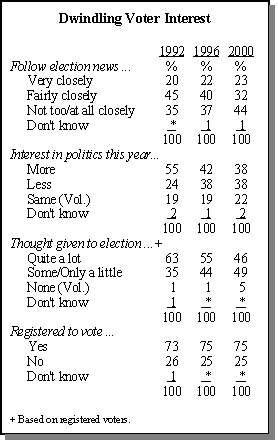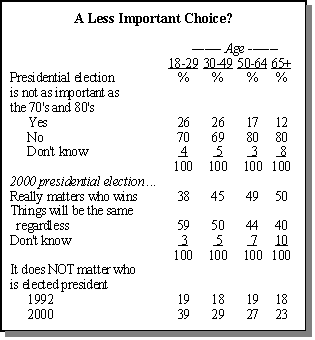Introduction and Summary
Americans are more satisfied with their choice of presidential candidates this year than in 1996 and 1992, and they are, if anything, less critical of the way the campaigns are being conducted and covered by the news media than they were at comparable points in those elections. Yet voters are more disengaged than they have been in the recent past, and these early indications suggest that turnout may be even lower than it was four years ago.
 Two main factors appear to underlie flagging voter interest. First, many citizens say that who is elected president is not as important as it once was. Secondly, younger Americans are more cynical and disconnected from politics than even in the recent past. These are the principal findings of a nationwide survey of voter attitudes by the Pew Research Center, which is comparable to polls conducted by the Center at about this stage in the two previous presidential elections.
Two main factors appear to underlie flagging voter interest. First, many citizens say that who is elected president is not as important as it once was. Secondly, younger Americans are more cynical and disconnected from politics than even in the recent past. These are the principal findings of a nationwide survey of voter attitudes by the Pew Research Center, which is comparable to polls conducted by the Center at about this stage in the two previous presidential elections.
At this point, there is a good chance that voter turnout will be lower than in 1996, when just 49% of age-eligible citizens cast ballots. And it seems virtually certain that participation will fall below the 55% who voted in 1992. There are several signs pointing to a possible decline in voter turnout, despite the highly competitive nature of the race between Al Gore and George W. Bush.
First, fewer respondents say they have been following news about the campaign than in 1996 and 1992, and an increasing number say they are less interested in politics this year. While the poll finds no decline in the percentage of Americans registered to vote, not as many potential voters say they are focused on the campaign as in the past.
At the same time, there are strong indications Americans do not place as much importance as they once did on who is elected president. One-in-five flatly agree with the statement that who is elected is not as important as it was in the 1970s and 1980s. Perhaps more tellingly, 30% said it does not make much difference who is elected, up from 18% in surveys conducted in 1992 and 1976. Cynicism over what the next president can achieve is running at the same level as it was in August 1976, when the country was still recovering from Watergate and the oil shortages of the mid-1970s. Then, as now, nearly half agreed that “things will pretty much be the same” no matter who is elected.
In this vein, while 37% say they are having trouble choosing between Gore and Bush because they believe neither is qualified, almost as many say they are having trouble because either would be qualified. A bare majority of voters think Gore and Bush have different positions on issues. In fact, the percentage saying the two men take similar positions is somewhat higher than it was before the campaigns began in earnest a year ago (33% vs. 24%).
 Generational factors are evident in both the declining voter interest and the diminishing view of the presidency. While Americans in all age groups are less engaged by the current presidential campaign, the falloff is sharper among voters under 50 years of age. Only about half of those in that age group are paying close attention to news about this year’s presidential campaign, compared to nearly two-thirds of those age 50 and older. This generation gap in attentiveness was not as apparent four years ago at this time. In addition, increasing numbers of younger people say they don’t vote because of their distaste for politics and dislike of candidates.
Generational factors are evident in both the declining voter interest and the diminishing view of the presidency. While Americans in all age groups are less engaged by the current presidential campaign, the falloff is sharper among voters under 50 years of age. Only about half of those in that age group are paying close attention to news about this year’s presidential campaign, compared to nearly two-thirds of those age 50 and older. This generation gap in attentiveness was not as apparent four years ago at this time. In addition, increasing numbers of younger people say they don’t vote because of their distaste for politics and dislike of candidates.
Younger Americans are also much more likely to express doubts about the power and prestige of the presidency. Those under age 50 are much more likely than older Americans to say that it is less important who is elected; more younger people also believe the next president won’t change things. Since 1992, a growing number of people in every age group say it does not matter who is elected president. But the increase among those under age 50 holding this view is more than double the increase among older people.
In part, these trends reflect uncertainty and divisions over how much change the country actually wants. A slim plurality supports making major policy changes to solve problems rather than staying the course. While there is an obvious partisan undertone in the debate over change vs. continuity, nearly one-third of Republicans support staying the course and independents are fairly evenly split on the desire for change.
Paradoxically, the signs of the public’s political listlessness are surfacing at a time when many more Americans express satisfaction with their choice of candidates than did so four years ago. Satisfaction with the presidential field has risen dramatically among Republicans; nearly three-quarters (73%) express satisfaction with the candidates compared to 49% in 1996. Independents and Democrats are also more pleased with the field than they were in 1996. Similarly, the Bush campaign is getting better grades from voters than did GOP standard-bearer Bob Dole’s campaign of four years ago. Gore’s effort is less highly-rated, but is judged about the same as Clinton’s campaign was during the summer of 1996.
 Many indicators in the survey suggest that the presidential race is still wide open, especially when compared to the relatively unchanging tenor of voter opinions four years ago. The Pew Center’s surveys have fluctuated since the primary season ended in the spring. In mid-March, after the primaries, Gore moved out to a six-point lead among registered voters. In contrast, surveys in May and early June found the race dead even. The most recent survey, conducted from June 23-30 — after the renewed controversy over Gore’s possible fund-raising improprieties — found a small lead for Bush (42%-35%). Four years ago, Clinton held a consistent lead over Dole in all Pew Research Center post-primary surveys.
Many indicators in the survey suggest that the presidential race is still wide open, especially when compared to the relatively unchanging tenor of voter opinions four years ago. The Pew Center’s surveys have fluctuated since the primary season ended in the spring. In mid-March, after the primaries, Gore moved out to a six-point lead among registered voters. In contrast, surveys in May and early June found the race dead even. The most recent survey, conducted from June 23-30 — after the renewed controversy over Gore’s possible fund-raising improprieties — found a small lead for Bush (42%-35%). Four years ago, Clinton held a consistent lead over Dole in all Pew Research Center post-primary surveys.
The poll also finds voters expressing less conclusive attitudes toward the candidates this time. Four years ago, 74% of registered voters had firmly decided not to cast a ballot for either Clinton or Dole. This year fewer (66%) have made that judgment regarding Gore and Bush. Independents are especially non-committal — only 56% have ruled out one of the candidates, compared to 64% four years ago. The current polling also finds slightly more undecided voters (9%) than in June 1996 (5%), but fewer than in June 1992 (14%).
But Bush’s campaign can point to promising signs. Currently, the Texas governor has an enthusiasm edge over Gore; his support is firmer than the vice president’s, particularly from within his own party base. In addition, core Republicans, especially conservatives, are more likely to say who gets elected matters and they are paying closer attention to the race than liberal Democrats.
Gender continues to be one of the most important prisms for understanding the presidential race. Men have more consistently favored Bush, while women have vacillated in their support for Gore. Younger women, who decisively favored Clinton over Dole four years ago, are especially torn between Bush and Gore. Suburbanites, white Catholics, mainline Protestants, and middle-income voters have also been consistently on the fence in recent months.
While the majority of Americans regard the presidential race as dull, fewer feel that way than did four years ago (65% vs. 73%). And they are not inclined to blame the news media for their lack of interest in the campaign. Nearly half of Americans (48%) rate the media’s coverage of the campaign as good or excellent, compared to 42% in 1996. But while the public is moderately satisfied with how the press is reporting on the campaign, relatively few Americans are actively seeking out election news. In yet another indication of the public’s inattentiveness to this election, just 15% say they actually seek news about the campaign while 83% come across it by chance.
Although the public overwhelmingly wants the news media to focus on issues in covering this election, as opposed to stories about the candidates’ backgrounds and personal experiences, Americans rate a candidate’s reputation for honesty as the most important thing to learn before the election. No single issue dominates the voters’ concerns, but recent signs that the economy is cooling appear to have attracted increasing public interest. Relegated to the second-tier of issues a year ago, the economy is now one of a quartet of subjects — along with education, health care and Social Security — that voters want candidates to discuss.
Other Findings
A narrow majority of Americans believe that Bush will win the presidential election. At this point, Republicans are much more confident in their party’s chances in November than Democrats are in theirs.
The public is receptive to the idea of replacing paid TV ads with more frequent candidate debates. Republicans are slightly more enthused by that proposal — which Gore has promoted — than are Democrats.
Americans are divided over whether major new policy changes are needed, but just 40% want the next president to continue the programs and policies of the Clinton Administration.
Fewer people are getting news about the campaign from traditional media sources, including broadcast and cable television, radio and newspapers compared to four years ago. But among the minority of Americans who actively look for campaign news, nearly two-thirds turn to newspapers and cable.
While white evangelical Protestants overwhelmingly favor Bush over Gore, seculars are divided. Gore holds a slight lead over Bush among members of this group in a two-way race. But Green Party candidate Ralph Nader draws some of the vice president’s secular supporters, and in a four-way race (including Nader and Pat Buchanan) Gore and Bush run even.



